(Museum für Völkerkunde, Berlin.)
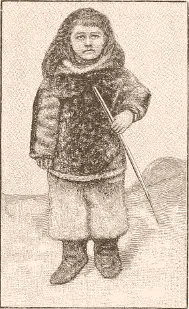
Fig. 512. Child’s clothing.
As to the mode of clothing of the other tribes I give the descriptions of the authors.
Parry describes the dress of the Iglulirmiut as follows (II, p. 495):
In the jacket of the women, the tail or flap behind is very broad, and so long as almost to touch the ground; while a shorter and narrower one before reaches halfway down the thigh. The men have also a tail in the hind part of their jacket, but of smaller dimensions; but before, it is generally straight or ornamented by a single scollop. The hood of the jacket ***is much the largest in that of the women, for the purpose of holding a child. The back of the jacket also bulges out in the middle to give the child a footing, and a strap or girdle below this, and secured round the waist by two large wooden buttons in front, prevents the infant from falling through when, the hood being in use, it is necessary thus to deposit it. ***The upper (winter) garment of the females, besides being cut according to a regular and uniform pattern, and sewed with exceeding neatness, which is the case with all the dresses of these people, has also the flaps ornamented in a very becoming manner by a neat border of deerskin, so arranged as to display alternate breadths of white and dark fur. This is, moreover, usually beautified by a handsome fringe, consisting of innumerable long, narrow threads of leather hanging down from it.This ornament is not uncommon also in the outer jackets of the men. When seal-hunting,they fasten up the tails of their jackets with a button behind.
The breeches and the foot gear of the men are described as being much the same as those of the Akudnirmiut. Parry remarks (loc. cit.) that several serpentine pieces of hide are sewed across the soles to prevent them from wearing out:
The inner boot of the women, unlike that of the men, is loose around the leg, coming as high as the knee joint behind, and in front carried up by a long, pointed flap nearly to the waist and there fastened to the breeches. The upper boot, with the hair as usual outside, corresponds with the other in shape, except that it is much more full, especially on the outer side, where it bulges out so preposterously as to give the women the most awkward, bow-legged appearance imaginable. ***Here, also, as in the jacket, considerable taste is displayed in the selection of different parts of the deerskin, alternate strips of dark and white being placed up and down the sides and front by way of ornament. The women also wear a moccasin (itigega) overall in the winter-time.
The dress of the Aivillirmiut is similar to that of the Igiulirmiut (Gilder, p. 139).
Traces of clothing found in old graves of Cumberland Sound and Frobisher’s description of the dress of the Nugumiut show that the style of clothing now used by the Igiulirmiut formerly obtained in all parts of Baffin Land.
All the Eskimo wear mittens. Those used in winter are made of the skin of young seals or of deerskin. In summer they use hairless sealskin, and sometimes make them with two thumbs, so as to turn the mitten round if one side should become wet.
The manner of dressing the hair practiced by the tribes of Northeastern Baffin Land differs from that of other tribes. On Davis Strait and in Hudson Bay the men allow it to grow to a considerable length, but frequently cut it short on the forehead. If all the hair is long it is kept back by a band made of the skin of deer antlers taken in the velvet. Sometimes these ties are very neatly finished. Frobisher states that the Nugumiut shaved part of their heads. The Kinipetu shave the top of the head; the Netchillirmiut wear their hair short.
The women have two styles of dressing their hair. They always part it on the top of the head. The back hair is wound into a bunch protruding from the back of the head or nicely arranged in a knot. The hair at the sides is plaited and folded over the ears, joining the knot behind. The other way is to arrange these parts in small pigtails reaching a little below the ears. They are kept in order by an ivory or brass ring (see Fig. 515).
The manner in which the Iglulirmiut dress their hair is thus described by Parry (II, p. 493):
They separate their locks into two equal parts, one of which hangs on each side of their heads and in front of their shoulders. To stiffen and bind these they use a narrow strap of deerskin, attached at one end to a round piece of bone, fourteen inches long, tapered to a point, and covered over with leather. This looks like a little whip, the handle of which is placed up and down the hair and the strap wound round it in a number of spiral turns, making the tail, thus equipped, very much resemble one of those formerly worn by our seamen. The strap of this article of dress, which is altogether called a tugliga, is so made from the deerskin as to show when bound round the hair, alternate turns of white and dark fur, which give it a very neat and ornamental appearance. ***Those who are less nice dispose ***their hair into a loose plait on each side or have one tugliga and one plait.
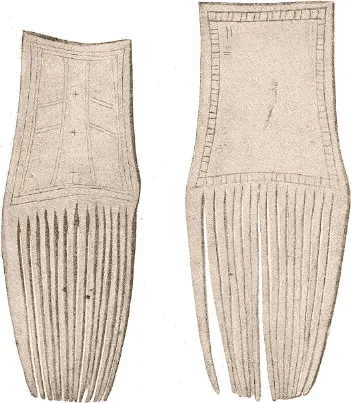
Fig. 513. Ivory combs. (National Museum, Washington. 10195.) 1/1
The natives of Southampton Island arrange their hair in a bunch protruding from the forehead (sulubaut). The same dress is worn at certain feasts on Davis Strait ( p. 608).
For dressing the hair ivory combs are in use, two specimens of which are represented in. Fig. 513.
The clothing is frequently trimmed with straps of white deerskin, giving it a pleasing appearance. The edge of the women’s jacket is adorned with ivory beads. Instead of these, teeth, deer’s ears, foxes’ noses, or brass bells are sometimes used.
The inner jackets of the men are sometimes trimmed with beads, feathers, or leather straps, forming a collar and figures of different kinds on the back and on the breast. An amulet is worn in the middle of the back ( p. 592). These ornaments and the amulet are only visible when the outer garment is taken off in the hut.
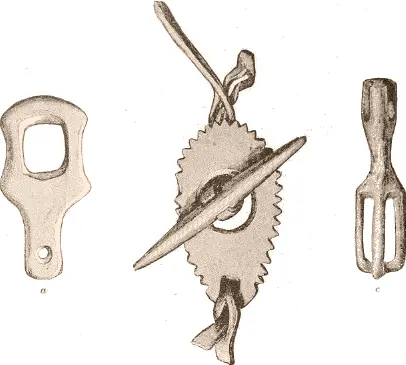
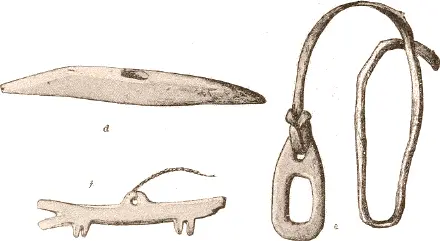
Fig. 514. Buckles. c (From Tununirnusirn.) (National Museum, Washington, a , 10196; b , 10400; c , 10177; d , 10196; e , 10195; f , 10207.) 1/1
Fig. 514 represents a number of buckles serving to carry needlecases or similar implements at the girdle, to which the eye is tied, the button being fastened to the implement. Head ornaments are in frequent use and are sometimes beautifully finished.
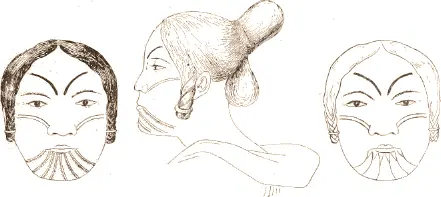
Fig. 515. Manner of tattooing face and wearing hair.
The women are in the habit of adorning their faces by tattooing. It is done, when they are about twelve years of age, by passing needle and thread covered with soot under the skin, or by puncture, the points of the tattooing instruments being rubbed with the same substance in both cases, which is a mixture of the juice of Fucus and soot, or with gunpowder, by which process they obtain a blue color. The face, arms, hands, thighs, and breasts are the parts of the body which are generally tattooed. The patterns will be seen in Figs. 515 and 516.
Читать дальше

















